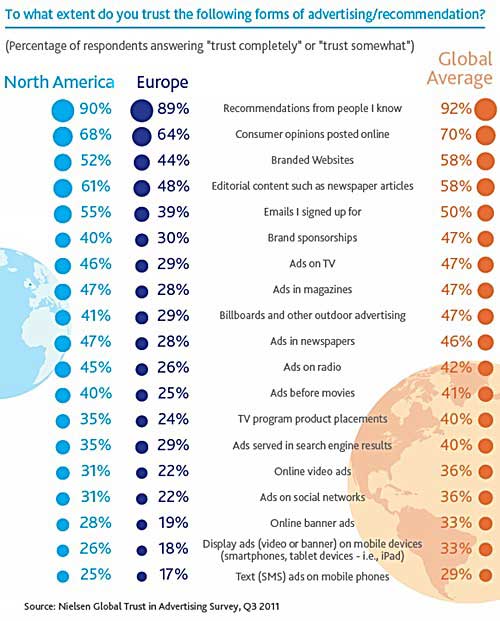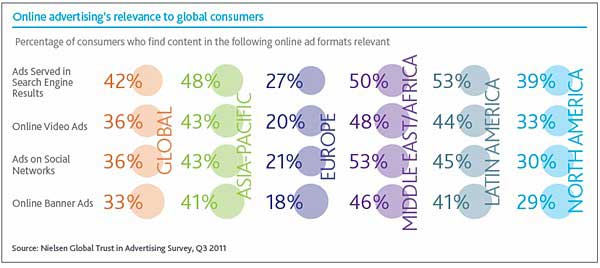Word-of-mouth (WOM) recommendations from friends and family and user-generated content (UGC) are sources most trusted for information about the products people want and need, according to a new report by Nielsen.
Among consumers surveyed in North America:
- 90% trust (completely or somewhat) the recommendations they receive from friends and family.
- 68% trust consumer opinions posted online.
- 61% trust editorial content such as newspaper articles.

Roughly one-third of North American consumers trust content they find on social media (31%), in online video ads (31%), and paid-search ads (35%), while only one in four say online banner ads (28%), display ads via smartphones and tablets (26%) and text ads on mobile phones (25%) are credible.
Global citizens are slightly more trusting than Americans of word-of-mouth recommendations (92% vs. 90%) and online consumer reviews (70% vs. 68%).
Global citizens also put more trust in social and mobile ads: 36% say they trust ads delivered via social media (vs. 31% for North Americans) and 33% say they trust display ads served via mobile devices (vs. 26%).
Europeans have the lowest levels of trust in all but one advertising/messaging format: consumer opinions posted online (64%).
Below, other findings from Nielsen's Global Trust in Advertising and Brand Messages Report, issued in April 2012.
Relevant advertising has room to grow.
Across online channels, only one-third of North American consumers find online banner ads (29%), ads on social networks (30%), and online video ads (33%) to be relevant. Ads served alongside search engine results fare slightly better, with 39% of North American consumers finding them personally relevant.

Among global consumers, fewer than four in ten find online banner ads (33%), ads on social networks (36%), and online video ads (36%) relevant, with 42% of global consumers find paid-search ads personally relevant.
Such findings support a recent US Nielsen study suggesting that, though some individual websites perform very well at reaching an ad campaign's intended audience, nearly all campaigns are delivered to consumers outside of the brand advertiser's intended audience.
Looking across dozens of campaigns spanning hundreds of websites, Nielsen found that, on average, ad campaigns with a relatively narrow audience are only reaching 35% of their desired audience group.
About the data: The Nielsen Global Trust in Advertising Survey was conducted in August and September of 2011 and polled more than 28,000 consumers in 56 countries throughout Asia Pacific, Europe, Latin America, the Middle East, Africa, and North America.



